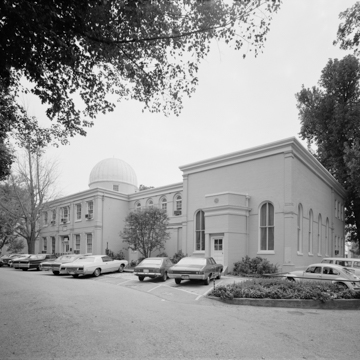A steep rock formation at the conjunction of Tiber Creek and the Potomac River, the former site of Marine Corps headquarters, became the site of the Naval Observatory in 1843. As the city developed thereafter, conditions for astronomical observations were compromised, and in 1893, the observatory moved to higher ground on Massachusetts Avenue. The site and buildings then were adapted for the Naval Medical Center, and eventually for the Naval Medical Command.
The hillside is dotted with yellow and red brick and limestone buildings dating from 1843 to the 1930s in a landscaped setting of shrubs and oaks. The centerpiece is a two-story Italianate style building constructed of creamy yellow brick with a wooden dome sheathed with copper, known as Building Two. During the years that it served as the Naval Observatory, the dome of the building revolved on six-pound cannonballs set in a grooved cast-iron rail; within, a 9.6-inch German telescope rested on a stone and brick pier designed to lessen vibration. Ornate wrought-iron railings and Doric pilasters decorate the front and rear facades. From the top of the hill, spectacular views are afforded of monumental Washington, the Potomac River, and the Arlington, Virginia, skyline.














